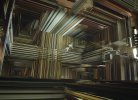I hope so. Night Trap did that on Sega CD every time you switched cameras/rooms using a 150KB/s CD drive. Load times and asset management are a design choice.
We already have 1 second (or near enough) complete reloads of content in the form of Ratchet moving through the dimensional portal. The question here though is whether that would happen as part of normal gameplay from a simple camera turn at any given point in the game which would imply a 360 degree turn of the camera consumes a very large percentage of the games art content - around 25% of the content in a game the size of R&C for example.
So while not technical impossible, it's practically extremely unlikely unless the game is going to be extremely unvaried in art content. Essentially one environment that repeats over and over again.



